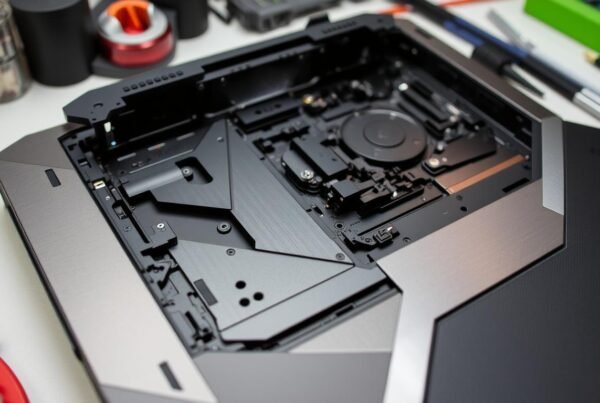Ever thought that more CPU cores mean better performance? This idea is common but not always true. Let’s explore the complex world of multi-core performance and CPU utilization to find out why.
In parallel computing, more cores seem to offer more power. But, the truth is more complex. Things like transmission time, heat, and power needs can limit the gains from extra cores. The relationship between cores and performance depends on the task and how well software is written.
Imagine CPU cores as workers in a factory. More workers don’t always speed up work if tasks can’t be split evenly or if there’s not enough work. Similarly, in processors, Amdahl’s law shows that adding cores has its limits.
Contents
- 1 Understanding CPU Core Basics
- 2 The Physics Behind CPU Core Limitations
- 3 Why More CPU Cores Aren’t Always Better
- 4 The Real-World Impact on Gaming Performance
- 5 Software Optimization and Core Utilization
- 6 Core Scaling in Professional Applications
- 7 The Role of Thread Management
- 8 Finding the Sweet Spot for Your Needs
- 9 Conclusion
- 10 FAQ
- 10.1 Do more CPU cores always lead to better performance?
- 10.2 What is the difference between single-core and multi-core processors?
- 10.3 How does clock speed affect CPU performance?
- 10.4 Why don’t CPUs keep increasing in clock speed?
- 10.5 How important are CPU cores for gaming performance?
- 10.6 What is software optimization and why is it important for multi-core CPUs?
- 10.7 How do professional applications benefit from higher core counts?
- 10.8 What is hyperthreading and how does it affect performance?
- 10.9 How many CPU cores do I need for general computing and gaming?
- 10.10 What are the main factors limiting multi-core performance scaling?
Key Takeaways
- More CPU cores don’t guarantee better performance in all scenarios
- Task-specific requirements greatly influence core utilization
- Software optimization plays a crucial role in multi-core efficiency
- Amdahl’s law explains the limitations of performance scaling with additional cores
- Heat and power constraints impact the benefits of increasing core count
- Understanding core utilization is vital for making informed hardware choices
Understanding CPU Core Basics
CPUs are the brains of our computers. Knowing how they work is crucial for understanding performance. Let’s explore CPU cores and how they affect your system’s speed.
What is a CPU Core and How Does it Work
A CPU core is the main part of the processor. It reads and executes instructions. Modern CPUs often have multiple cores.
An eight-core CPU is like a single CPU with 8 cores and 16 logical processors. This setup helps with multitasking and faster processing.

Single-Core vs Multi-Core Architecture
Single-core processors handle one task at a time. Multi-core processors can do many tasks at once. This is where core count matters.
More cores mean more tasks can be handled at once. This improves performance for demanding applications.
The Role of Clock Speed in CPU Performance
Clock speed, measured in GHz, affects a core’s speed. It’s not just about core count. The clock speed of each core is important too.
A CPU with a higher clock speed can process instructions faster. Some CPUs even have turbo speed. This boosts clock speed for demanding tasks.
| CPU Type | Core Count | Clock Speed | Performance |
|---|---|---|---|
| Single-Core | 1 | 3.5 GHz | Good for basic tasks |
| Quad-Core | 4 | 3.2 GHz | Better multitasking |
| Octa-Core | 8 | 2.9 GHz | Excellent for heavy workloads |
The interplay between core count, clock speed, and CPU architecture determines performance. It’s not just about having the most cores. It’s about finding the right balance for your needs.
The Physics Behind CPU Core Limitations
CPU performance isn’t just about adding more cores. Physical limitations play a crucial role in determining how well a processor can function. Let’s dive into the key factors that affect CPU capabilities.
Transmission Time and Signal Processing
As clock speeds increase, transmission time becomes a limiting factor. The speed of light sets an ultimate limit on how fast signals can travel within a CPU. This means that even tiny distances on a chip can cause delays at high frequencies.

Heat Dissipation Challenges
Heat dissipation is a major hurdle in CPU design. As processors work harder, they generate more heat. This can lead to thermal throttling, where the CPU slows down to prevent damage. Cooling solutions have improved, but heat remains a significant constraint on performance.
Power Consumption Scaling
Power consumption rises rapidly with clock speed. This scaling creates a dilemma: faster speeds require more power, which in turn generates more heat. It’s a vicious cycle that limits how fast we can push single cores.
| Factor | Impact on CPU Performance | Limiting Effect |
|---|---|---|
| Signal Transmission | Delays in data processing | Speed of light limit |
| Heat Dissipation | Thermal throttling | Cooling efficiency |
| Power Consumption | Increased energy needs | Power delivery and heat |
These physical constraints have pushed manufacturers towards multi-core designs. By spreading tasks across multiple cores, CPUs can improve performance without hitting these bottlenecks. Yet, even multi-core designs face challenges in scaling and efficiency.
Why More CPU Cores Aren’t Always Better
The quest for more CPU cores doesn’t always mean better performance. While it seems like a good idea, it’s not for everyone. Many things affect how well more cores help with speed and efficiency.
Thread contention is a big problem with more cores. When many threads fight for the same resources, it slows things down. This is especially true for apps not made for running in parallel.
Memory bandwidth can also hold things back with lots of cores. When many cores try to get to memory at once, it can’t handle the data fast enough. This can make extra cores less useful.
How well software is made to use many cores matters a lot. Many apps aren’t made to use lots of cores well. For example:
- Simple tasks like browsing the web or writing documents might only use 1-2 cores
- Video editing software can really use 4-8 cores
- 3D rendering might need 16 or more cores to work well
Managing tasks gets more complicated with more cores. Operating systems have to work harder to spread out tasks evenly. This can sometimes make extra cores not worth it for all tasks.
The Real-World Impact on Gaming Performance
Gaming performance isn’t just about CPU cores. Let’s explore how different parts of a processor impact your gaming.
Gaming Workload Distribution
Games use cores in various ways. Some games focus on one core, while others use many. This affects how much CPU cores matter for gaming.
Single-Thread vs Multi-Thread Gaming Tasks
Many games rely on single-threaded performance. This means clock speed is often more important than core count. For example, in Hogwarts Legacy at 1080p, a newer 6-core CPU outperformed an older one by up to 62%, regardless of settings.
GPU and CPU Interaction in Gaming
The interaction between GPU and CPU is key. While GPUs handle most 3D graphics, CPUs manage game logic and AI. This interaction can greatly affect frame rates and smoothness.
Here are the differences between the Zen 3 and Zen 4 architectures in terms of performance.
| Game | CPU Model | Performance Increase |
|---|---|---|
| Counter-Strike 2 | Ryzen 5 7600 zen4 vs 3600 zen3 | 64% at 1080p |
| Starfield | Ryzen 5 7600 zen4 vs 3600 zen3 | 54% at low settings |
| Hogwarts Legacy | Ryzen 5 7600 zen4 vs 3600 zen3 | 62% at 1080p |
These comparisons show that newer CPUs with better single-threaded performance can greatly improve gaming. This highlights the need to look beyond core count when choosing a CPU for gaming.
Software Optimization and Core Utilization
The rise of multi-core processors has changed computing. But, software optimization is still crucial to use them fully. Developers face challenges in making tasks run smoothly across multiple cores. Good software optimization can greatly improve performance on systems with many cores.
Parallel processing isn’t the same for all. Some apps, like AMBER for molecular dynamics, mostly use GPUs. Others, like Finite Element Analysis, need both GPU and CPU for complex tasks.
The effect of software optimization varies by industry:
- Gaming: CPU core parking and frequency scaling impact real-time performance
- Cloud computing: Providers split core groups for tasks like web apps and microservices
- Professional applications: Video editing and 3D rendering get better with optimized multi-core use
Recent breakthroughs show how vital software optimization is. AMD’s 128-core EPYC 9454 processor shows the power of parallel processing. But, its lower base clock speed of 2.25GHz shows the need for smart task distribution to get the most out of it.
Effective software optimization can turn a good multi-core system into a great one, unlocking hidden performance potential.
As more cores are added, software optimization gets more complex. Developers must manage task distribution, data consistency, and resources. This is to make apps that fully use the power of today’s multi-core processors.
Core Scaling in Professional Applications
Professional apps really test CPUs. Tasks like video editing, 3D animation, and virtual machines need multiple cores. But how much do more cores really help? Let’s explore how core counts affect performance in professional computing.
Video Editing and Rendering
Video editors will love more cores. They speed up your work. Rendering tasks get split, reducing processing time.
An 8-core CPU can handle most video editing tasks. But, adding more cores doesn’t always double your speed.
3D Animation Requirements
3D artists need lots of computing power. Complex scenes and effects use a lot of CPU. A 16-core CPU is great here, improving multitasking.
It lets you work on one part of a project while another is rendering. But, software must be optimized to use all cores well.
Virtual Machine Performance
Running multiple virtual machines? Core count is very important. Each VM can have its own core, making the system more responsive. An 8-core CPU can handle several VMs easily.
More cores mean smoother multitasking in your virtual environments.
| Application | Minimum Cores | Optimal Cores | Performance Gain |
|---|---|---|---|
| Video Editing | 4 | 8-16 | High |
| 3D Animation | 8 | 16-32 | Very High |
| Virtual Machines | 4 | 8-16 | Moderate |
More cores can improve performance, but it’s not always a straight increase. Software optimization, memory speed, and storage are also important. For most professionals, finding the right balance between core count and other specs is crucial for better productivity.
The Role of Thread Management
Thread management is key to better CPU performance. It’s not just about having many cores. It’s also about how well those cores work together. Let’s explore how cpu multithreading affects your computer’s speed.
Hyperthreading Technology
Hyperthreading changes the game in CPU design. It lets one core handle many threads at once. This tech, found in Intel chips, greatly improves performance in apps that use many threads.
Task Scheduling Efficiency
Task scheduling is the heart of multi-threading. It picks which thread runs on which core and when. Good task scheduling can greatly improve CPU performance, especially in tasks like video editing or 3D rendering.
Core-to-Thread Ratio Impact
The link between cores and threads isn’t simple. Sometimes, more threads than cores can lead to better performance. For example, in tasks that rely on I/O, having more threads than cores can make better use of CPU time.
| Thread Count | Execution Time (s) | Performance Gain |
|---|---|---|
| 4 (matching cores) | 100 | Baseline |
| 128 (over-provisioned) | 85 | 15% faster |
This data shows a 15% speed boost with 128 threads on a 4-core processor for some tasks. It shows the benefits of smart thread management in cpu multithreading.
Finding the Sweet Spot for Your Needs
Choosing the right CPU is about finding the right mix of core count, clock speed, and cache size. Multi-core processors are great for different tasks, but finding the perfect balance isn’t always easy. Let’s look at how to pick the best CPU for you.
For everyday tasks and light multitasking, 4-6 cores are usually enough. Gamers might prefer 6-8 cores for better performance. For professional tasks, you might need 8-16 cores or more, depending on how demanding the work is.
Cache size is also key to CPU performance. Bigger caches often mean better performance. When picking a processor, think about these points:
- Clock speed: Faster speeds can make up for smaller caches
- Workload type: Some tasks benefit from more cores, others don’t
- RAM: Workstations might need 64GB or more of RAM
- GPU: Important for tasks like video editing and rendering
Let’s compare three processors to show the trade-offs:
| Processor | Base Clock | Max Turbo | Cache Size | TDP | Max Memory | Price |
|---|---|---|---|---|---|---|
| i9 9900K | 3.6GHz | 5.0GHz | 16 MB | 95W | 64 GB | $500 |
| i7 9800X | 3.8GHz | 4.5GHz | 16.5 MB | 165W | 128 GB | $600 |
| Xeon 2145W | 3.7GHz | 4.5GHz | 11 MB | 140W | 512 GB | $1113 |
The right CPU depends on your needs and budget. Think about your main tasks, how much you might need in the future, and the overall balance of your system. This will help you make the best choice.
Conclusion
In the world of CPUs, more cores aren’t always better for performance. Manufacturers often highlight high core counts, but it’s more complex than that. For tasks like video editing and scientific calculations, more cores help a lot.
However, in gaming, where tasks are less parallel-friendly, a quad-core CPU might be enough. This shows that the needs of different tasks vary greatly.
The physics behind CPU design explains why adding more cores isn’t a simple fix. As clock speeds rise, power consumption and heat become big issues. This is why adding more cores is often preferred over increasing clock speeds.
Currently, the overclocking world record is just under 9 GHz. This highlights the challenges of pushing clock speeds too high.
Modern CPUs improve performance in many ways. They optimize instruction efficiency, use pipelining, and include special instructions like SSE and AES-NI. The main point is to choose a CPU based on your specific needs.
For most users, finding a balance between core count, clock speed, and other system components is key. Remember, the importance of more CPU cores depends on your unique computing needs.









